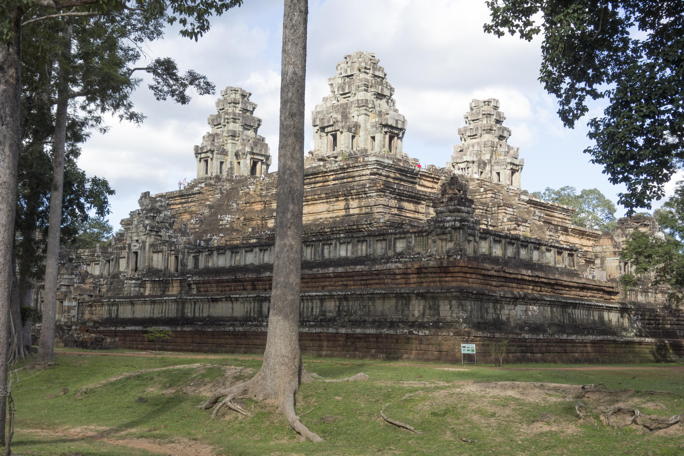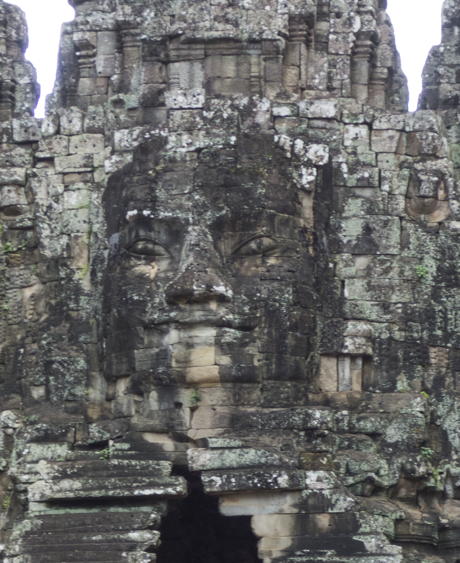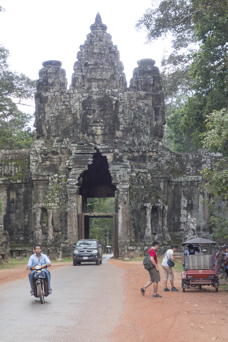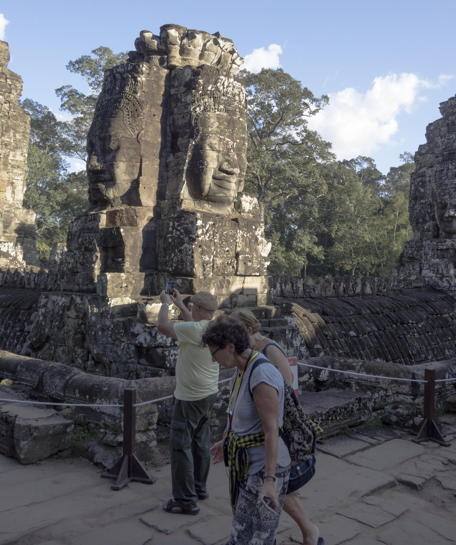
having been begun around +1000. We just stopped outside it long enough to take pictures.
You can get a slightly larger version, too.

|
|
This is Ta Keo,
a temple that’s not a part of Angkor Thom. In fact, it dates from much earlier, having been begun around +1000. We just stopped outside it long enough to take pictures. You can get a slightly larger version, too. |
If you’ve ever seen pictures of Angkor, they almost certainly were of the roots climbing over everything in Ta Prohm, or of the monumental heads in Angkor Thom. For me, to see Angkor has been an ambition ever since my teens, and what I was thinking of most of the time was this “Great City” (which is what Angkor Thom means) and the immense sculptural features of the architecture.

|
|
If these faces really are those of
King
Jayavarman VII, who built this city, they must be the most expressive of all history’s swelled heads. (Larger version.) This is the top of the arch over the east gate to the city. |
We entered the great city by the East Gate, and immediately climbed up to get a view of the monumental heads of this tower.

The East Gate (big image, small). When I look at the design of the arch here, I think immediately of much older examples of corbelled construction, like the so-called Treasury of Atreus and the Lion Gate, both in Mycenae.
I know little about architecture, and didn’t give any kind of thought to the construction of the arches and vaults that we were seeing here in the Angkor complex. But on looking at the pictures, and thinking of architectural history, I’m a little surprised here that the arches are all of the corbelled type, gotten by laying stones progressively closer over the passageway till they meet at the top. This is the most ancient way of fashioning an arch, and in my naivety, I rather assumed that by the time of the construction of these monuments, less than a millennium ago, the true arch would have been used instead. You can see that the engineers here were plenty skilled, so you can’t credit them with any kind of primitiveness or ignorance. There must have been more going on than I’m privy to.
|
The Bayon temple, which
sits inside Angkor Thom. We first admired from the outside, then went in. (11-second clip) |
The Bayon enjoys pride of place pretty much at the center of Angkor Thom. For a while we stood outside while a group of young monks descended from within, each holding what seemed to be an iPad. I have inordinately many snaps of these fellows, and have shown only two of them.
After standing outside Bayon for a little
while, we entered and had lots more opportunity for taking photographs,
and above, you see a tiny fraction of the pictures I took there. Most
of those were what we saw after climbing a stair and getting out into
the open where there were crowds of people. In my excitement to get
one more shot, I got separated from the group (or they got
separated from me) and it took me a good little while in the mazelike
passages up there to find them again.

|
| My very last picture from this day, or almost. ( Larger image.) |
After Bayon, we went to the Elephant Terrace, and there I shot a very inferior video in which the marching elephants show up too poorly. From there, to a much-needed shower back in the hotel, and then our dinner for which we congregated at 7:30; the meal ended only around 10:00, and we went right to bed.
We had piled three big tourist attractions into this one day: the Thousand Lingams, Ta Prohm, and Angkor Thom. It was a demanding schedule, and my feet knew it. Tomorrow would be devoted to Angkor Wat and a celebratory lunch in a fine restaurant. But you’ll have to go to the next page to learn about that.